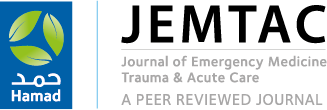-
oa Qatar's National Initiative to Assess and Enhance Patient Activation
- Source: Journal of Emergency Medicine, Trauma and Acute Care, Volume 2022, Issue 1 - Qatar Health 2022 Conference abstracts, Jan 2022, 68
-
- 27 July 2021
- 26 September 2021
- 03 December 2021
Abstract
Background: Qatar's National Health Strategy focuses on delivering care outside institutional settings in homes and communities. To successfully accomplish this, it is crucial to shift patient populations from being passive recipients of healthcare advice to active individuals taking control of their health.1 This work describes Qatar's initial steps to measure and enhance patient activation. Methods: A two-phased approach was adopted as follows:
-
• Phase 1: Assessment
The Patient Activation Measure (PAM)©2, a 13-question behavioral survey licensed through Insignia Health, was used to assess patient activation and ability to self-manage. A cross-sectional survey approach was adopted, in which 3,255 patients receiving governmental healthcare services were surveyed for the first time in Qatar between May 2020 and April 2021. • Phase 2: Enhancement
Clinical Health Coaching©3, an innovative approach grounded in motivational interviewing delivered by the Iowa Chronic Care Consortium, was used to transform the nature of the conversation between healthcare providers and patients. Two rounds of training were conducted with over 70 healthcare professionals successfully completing a two-month training program finishing in November 2021.
Results: Being the first of its kind to be conducted in Qatar, the study found:
-
• Phase 1: Assessment
The PAM© survey revealed that 21% of the patients were categorized as “feeling overwhelmed” (Level 1). 23% were “becoming aware” but still struggling (Level 2), 44% were categorized as “taking action” (Level 3) and 22% were categorized as “maintaining behaviors” (Level 4). • Phase 2: Enhancement
Training participants, to date, reported gaining practical skills to engage with patients to affect behavior change. Other key competencies gained included patient-centric care planning and building self-care skills. Conclusion: Patient activation is a critical factor in the successful delivery of healthcare services, particularly for patients with chronic or multiple chronic conditions. Measuring and improving patient activation has significant benefits to patients, providers, and health systems.
© 2022 Al Aufi, Sterling, Alemadi, Mismar, Al Raisi, Seoudi, licensee HBKU Press.


